Report on Introducing Professional Nursing: Standards and Codes
VerifiedAdded on 2022/09/12
|14
|3298
|21
Report
AI Summary
This report delves into the multifaceted world of professional nursing, examining critical components such as standards of practice, professional practice, and the code of conduct. It meticulously analyzes each standard, including critical thinking, professional relationships, capability maintenance, assessment, plan development, and the provision of safe, quality care. The report further explores professional practice, focusing on accountability, autonomy, and advocacy within the nursing context. Additionally, it provides a detailed overview of the code of conduct, particularly emphasizing person-centered care and cultural practice. The content includes real-world examples and practical strategies to illustrate key concepts, making it a valuable resource for nursing students and professionals seeking to understand and apply these principles in their practice. The report also emphasizes the importance of critical analysis, communication, and ethical considerations within the nursing profession, providing a comprehensive understanding of the roles and responsibilities of nurses in healthcare.
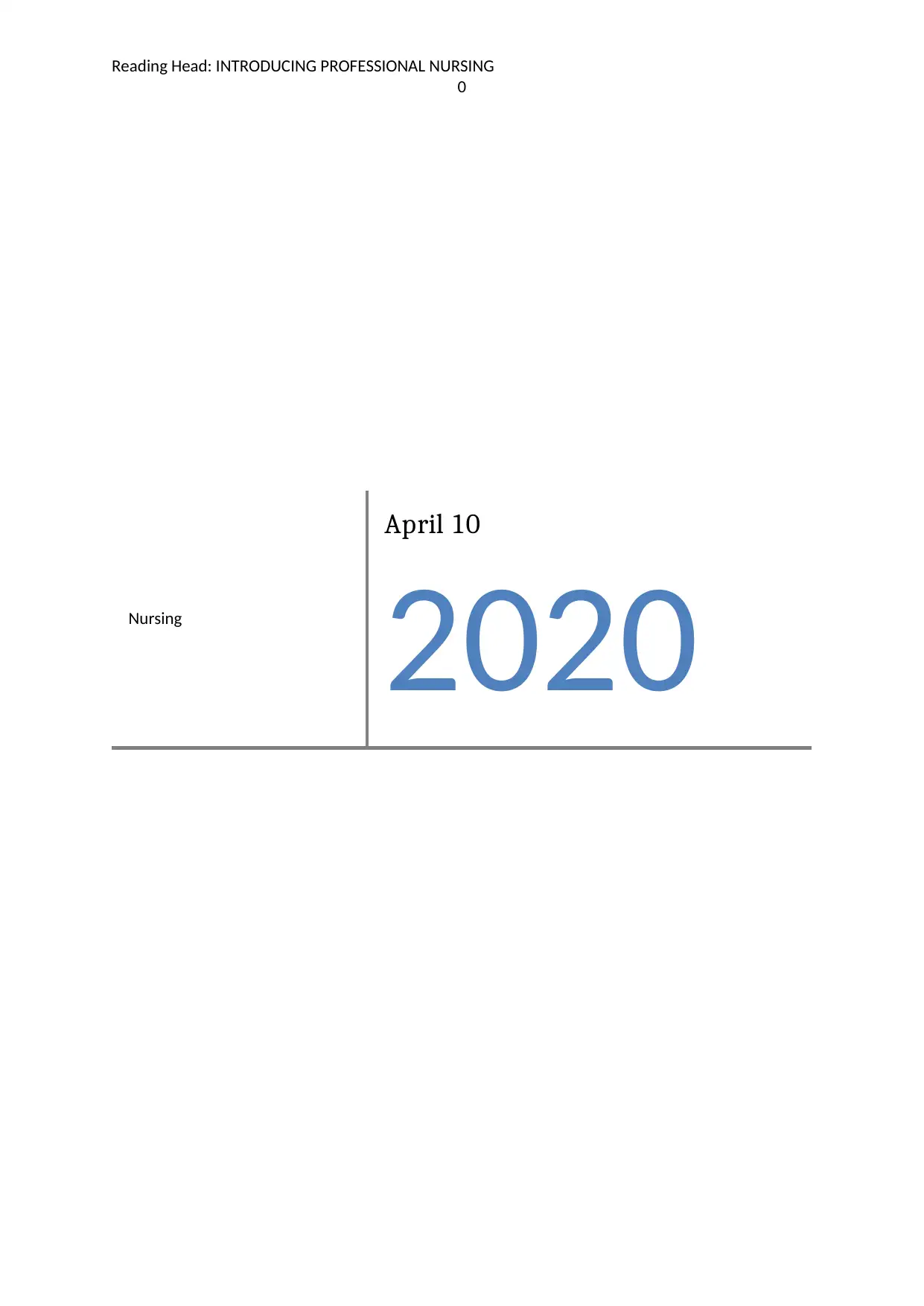
Reading Head: INTRODUCING PROFESSIONAL NURSING
0
Nursing
April 10
2020
0
Nursing
April 10
2020
Paraphrase This Document
Need a fresh take? Get an instant paraphrase of this document with our AI Paraphraser
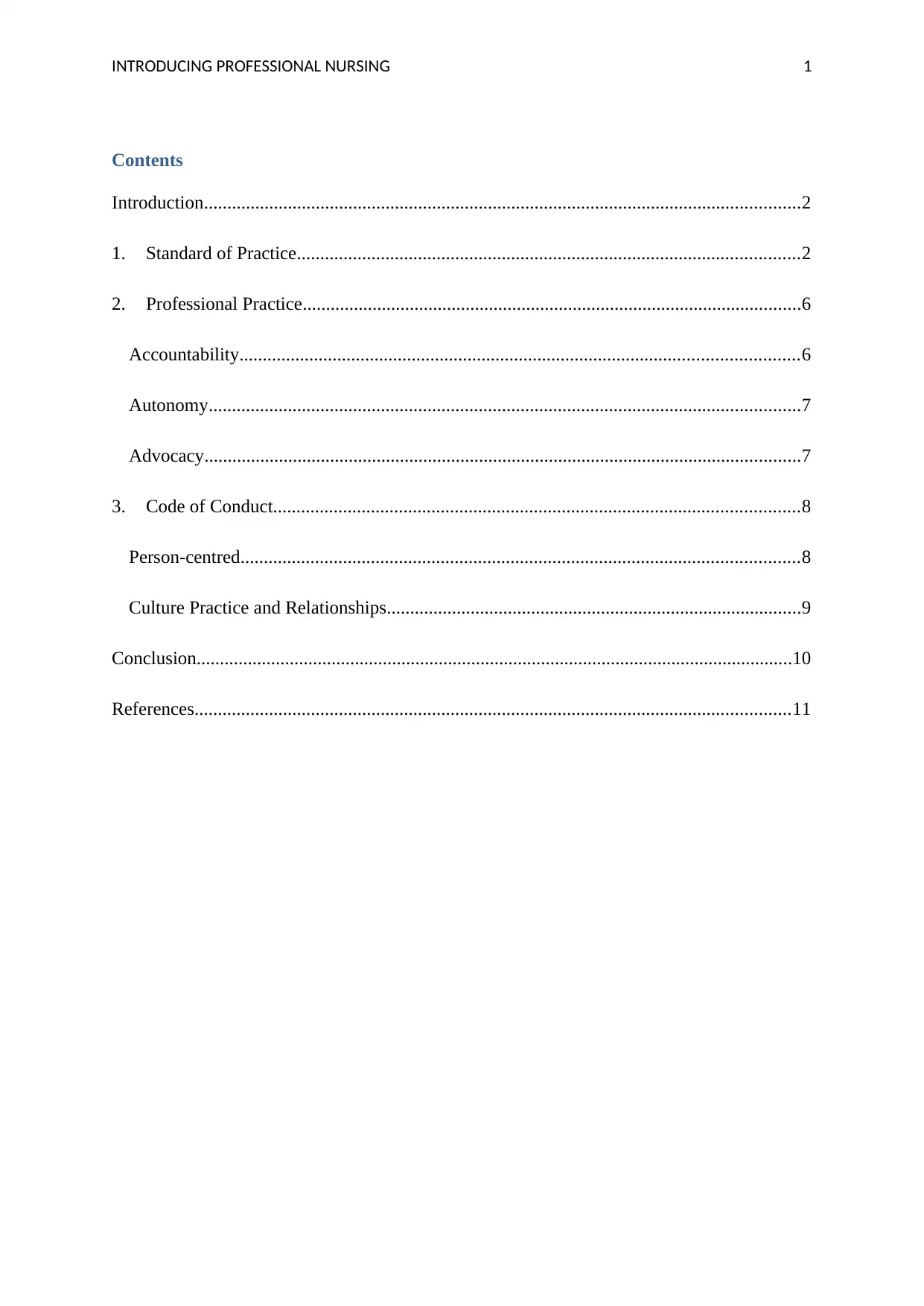
INTRODUCING PROFESSIONAL NURSING 1
Contents
Introduction................................................................................................................................2
1. Standard of Practice............................................................................................................2
2. Professional Practice...........................................................................................................6
Accountability........................................................................................................................6
Autonomy...............................................................................................................................7
Advocacy................................................................................................................................7
3. Code of Conduct.................................................................................................................8
Person-centred........................................................................................................................8
Culture Practice and Relationships.........................................................................................9
Conclusion................................................................................................................................10
References................................................................................................................................11
Contents
Introduction................................................................................................................................2
1. Standard of Practice............................................................................................................2
2. Professional Practice...........................................................................................................6
Accountability........................................................................................................................6
Autonomy...............................................................................................................................7
Advocacy................................................................................................................................7
3. Code of Conduct.................................................................................................................8
Person-centred........................................................................................................................8
Culture Practice and Relationships.........................................................................................9
Conclusion................................................................................................................................10
References................................................................................................................................11
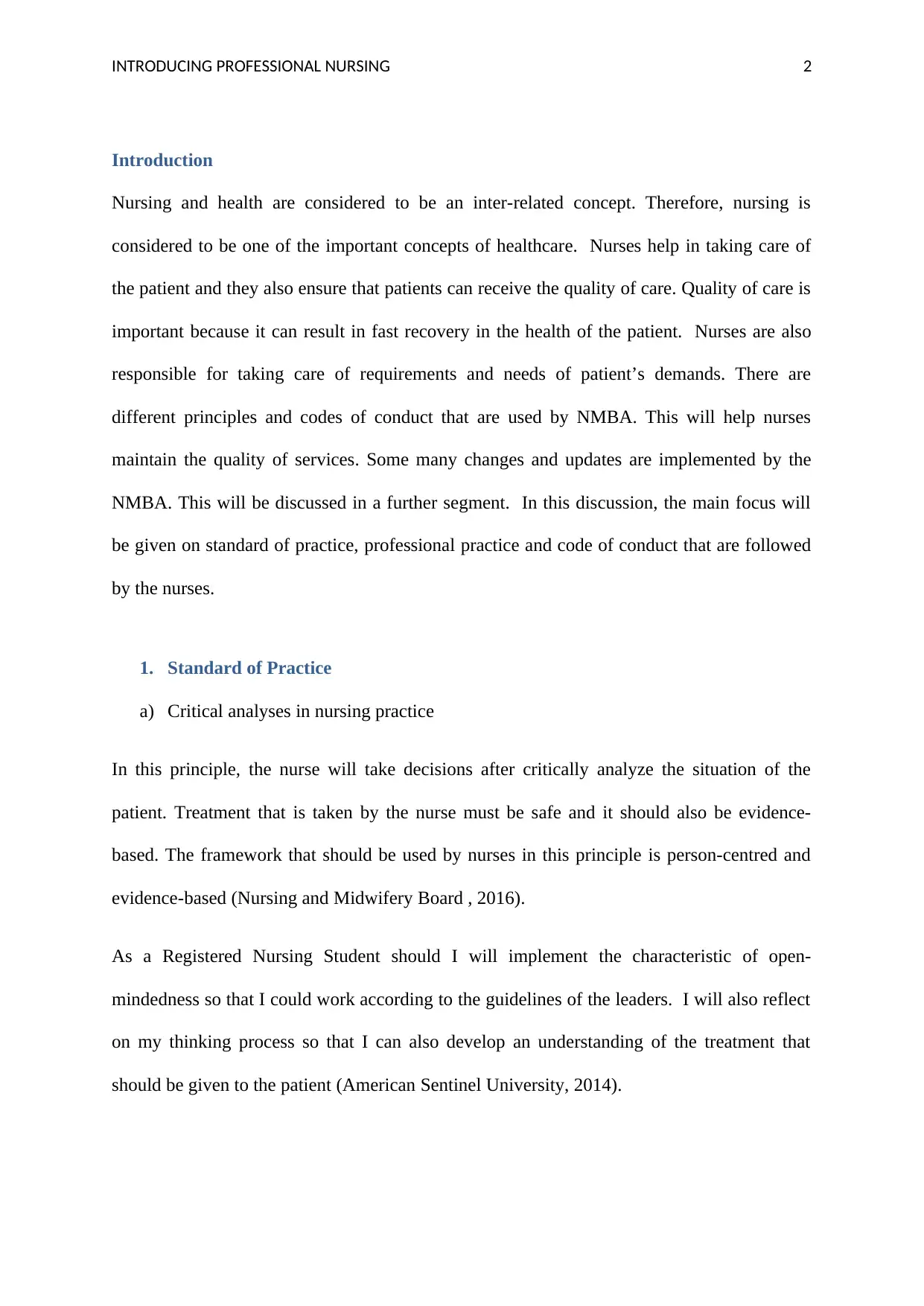
INTRODUCING PROFESSIONAL NURSING 2
Introduction
Nursing and health are considered to be an inter-related concept. Therefore, nursing is
considered to be one of the important concepts of healthcare. Nurses help in taking care of
the patient and they also ensure that patients can receive the quality of care. Quality of care is
important because it can result in fast recovery in the health of the patient. Nurses are also
responsible for taking care of requirements and needs of patient’s demands. There are
different principles and codes of conduct that are used by NMBA. This will help nurses
maintain the quality of services. Some many changes and updates are implemented by the
NMBA. This will be discussed in a further segment. In this discussion, the main focus will
be given on standard of practice, professional practice and code of conduct that are followed
by the nurses.
1. Standard of Practice
a) Critical analyses in nursing practice
In this principle, the nurse will take decisions after critically analyze the situation of the
patient. Treatment that is taken by the nurse must be safe and it should also be evidence-
based. The framework that should be used by nurses in this principle is person-centred and
evidence-based (Nursing and Midwifery Board , 2016).
As a Registered Nursing Student should I will implement the characteristic of open-
mindedness so that I could work according to the guidelines of the leaders. I will also reflect
on my thinking process so that I can also develop an understanding of the treatment that
should be given to the patient (American Sentinel University, 2014).
Introduction
Nursing and health are considered to be an inter-related concept. Therefore, nursing is
considered to be one of the important concepts of healthcare. Nurses help in taking care of
the patient and they also ensure that patients can receive the quality of care. Quality of care is
important because it can result in fast recovery in the health of the patient. Nurses are also
responsible for taking care of requirements and needs of patient’s demands. There are
different principles and codes of conduct that are used by NMBA. This will help nurses
maintain the quality of services. Some many changes and updates are implemented by the
NMBA. This will be discussed in a further segment. In this discussion, the main focus will
be given on standard of practice, professional practice and code of conduct that are followed
by the nurses.
1. Standard of Practice
a) Critical analyses in nursing practice
In this principle, the nurse will take decisions after critically analyze the situation of the
patient. Treatment that is taken by the nurse must be safe and it should also be evidence-
based. The framework that should be used by nurses in this principle is person-centred and
evidence-based (Nursing and Midwifery Board , 2016).
As a Registered Nursing Student should I will implement the characteristic of open-
mindedness so that I could work according to the guidelines of the leaders. I will also reflect
on my thinking process so that I can also develop an understanding of the treatment that
should be given to the patient (American Sentinel University, 2014).
⊘ This is a preview!⊘
Do you want full access?
Subscribe today to unlock all pages.

Trusted by 1+ million students worldwide
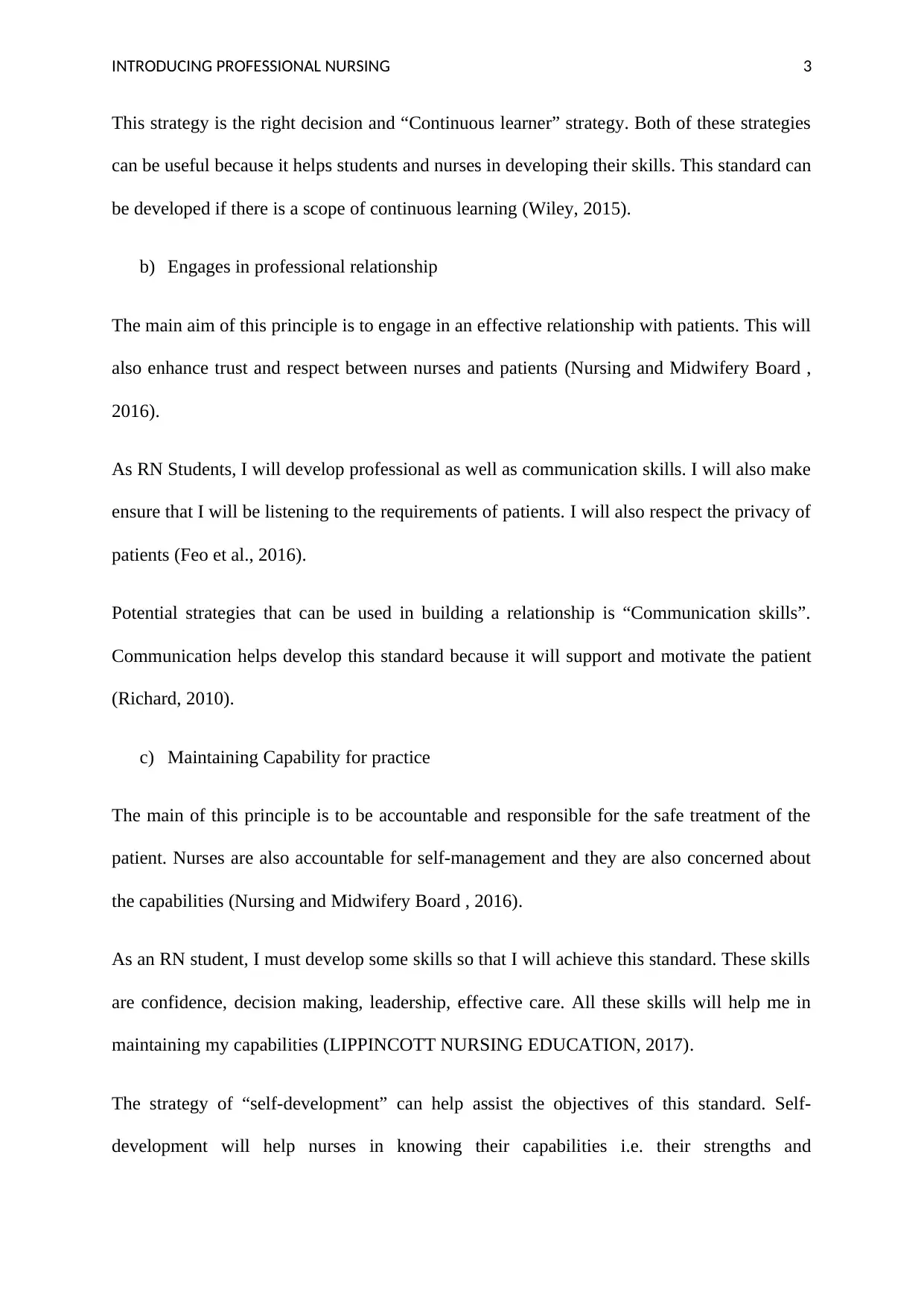
INTRODUCING PROFESSIONAL NURSING 3
This strategy is the right decision and “Continuous learner” strategy. Both of these strategies
can be useful because it helps students and nurses in developing their skills. This standard can
be developed if there is a scope of continuous learning (Wiley, 2015).
b) Engages in professional relationship
The main aim of this principle is to engage in an effective relationship with patients. This will
also enhance trust and respect between nurses and patients (Nursing and Midwifery Board ,
2016).
As RN Students, I will develop professional as well as communication skills. I will also make
ensure that I will be listening to the requirements of patients. I will also respect the privacy of
patients (Feo et al., 2016).
Potential strategies that can be used in building a relationship is “Communication skills”.
Communication helps develop this standard because it will support and motivate the patient
(Richard, 2010).
c) Maintaining Capability for practice
The main of this principle is to be accountable and responsible for the safe treatment of the
patient. Nurses are also accountable for self-management and they are also concerned about
the capabilities (Nursing and Midwifery Board , 2016).
As an RN student, I must develop some skills so that I will achieve this standard. These skills
are confidence, decision making, leadership, effective care. All these skills will help me in
maintaining my capabilities (LIPPINCOTT NURSING EDUCATION, 2017).
The strategy of “self-development” can help assist the objectives of this standard. Self-
development will help nurses in knowing their capabilities i.e. their strengths and
This strategy is the right decision and “Continuous learner” strategy. Both of these strategies
can be useful because it helps students and nurses in developing their skills. This standard can
be developed if there is a scope of continuous learning (Wiley, 2015).
b) Engages in professional relationship
The main aim of this principle is to engage in an effective relationship with patients. This will
also enhance trust and respect between nurses and patients (Nursing and Midwifery Board ,
2016).
As RN Students, I will develop professional as well as communication skills. I will also make
ensure that I will be listening to the requirements of patients. I will also respect the privacy of
patients (Feo et al., 2016).
Potential strategies that can be used in building a relationship is “Communication skills”.
Communication helps develop this standard because it will support and motivate the patient
(Richard, 2010).
c) Maintaining Capability for practice
The main of this principle is to be accountable and responsible for the safe treatment of the
patient. Nurses are also accountable for self-management and they are also concerned about
the capabilities (Nursing and Midwifery Board , 2016).
As an RN student, I must develop some skills so that I will achieve this standard. These skills
are confidence, decision making, leadership, effective care. All these skills will help me in
maintaining my capabilities (LIPPINCOTT NURSING EDUCATION, 2017).
The strategy of “self-development” can help assist the objectives of this standard. Self-
development will help nurses in knowing their capabilities i.e. their strengths and
Paraphrase This Document
Need a fresh take? Get an instant paraphrase of this document with our AI Paraphraser
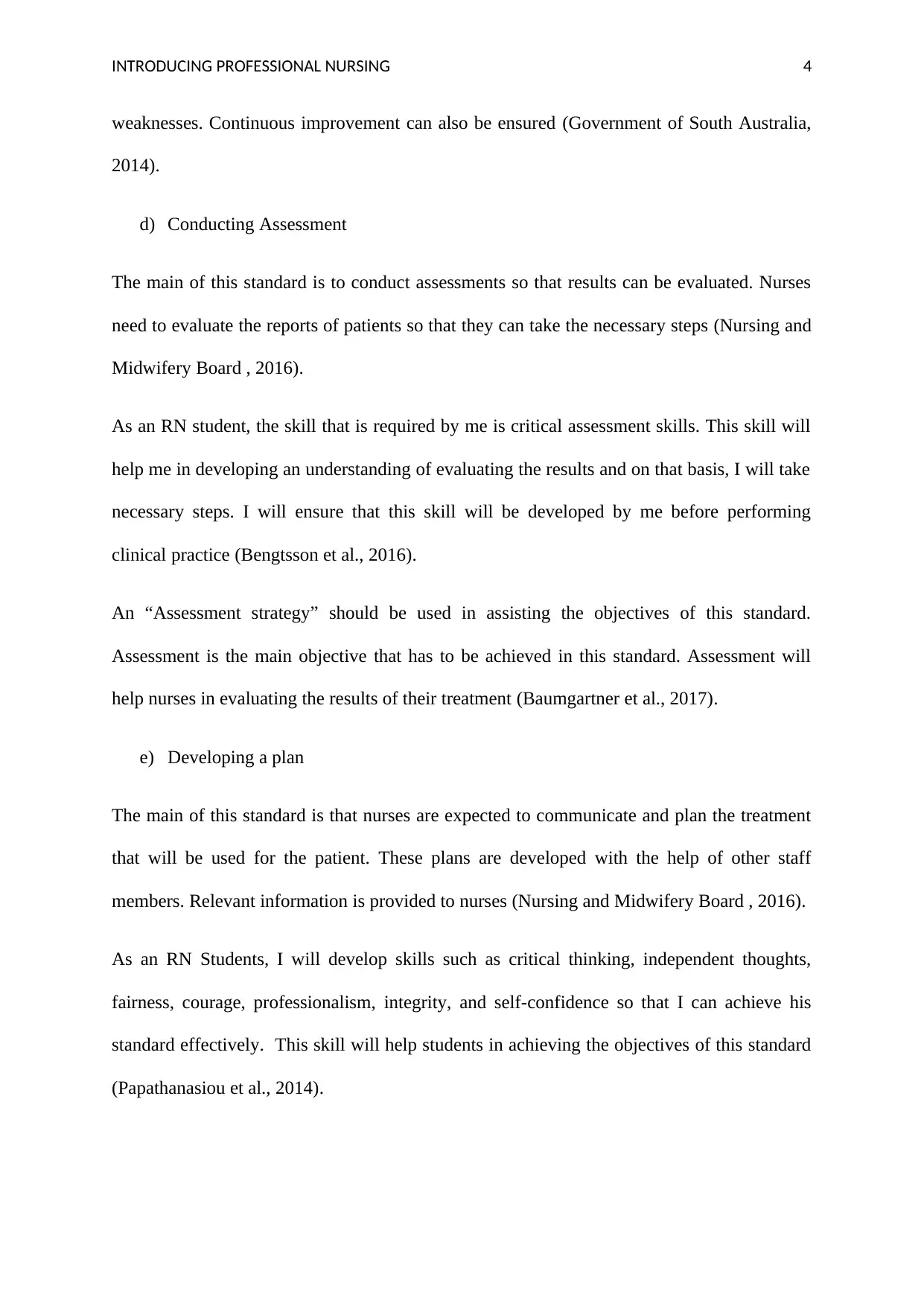
INTRODUCING PROFESSIONAL NURSING 4
weaknesses. Continuous improvement can also be ensured (Government of South Australia,
2014).
d) Conducting Assessment
The main of this standard is to conduct assessments so that results can be evaluated. Nurses
need to evaluate the reports of patients so that they can take the necessary steps (Nursing and
Midwifery Board , 2016).
As an RN student, the skill that is required by me is critical assessment skills. This skill will
help me in developing an understanding of evaluating the results and on that basis, I will take
necessary steps. I will ensure that this skill will be developed by me before performing
clinical practice (Bengtsson et al., 2016).
An “Assessment strategy” should be used in assisting the objectives of this standard.
Assessment is the main objective that has to be achieved in this standard. Assessment will
help nurses in evaluating the results of their treatment (Baumgartner et al., 2017).
e) Developing a plan
The main of this standard is that nurses are expected to communicate and plan the treatment
that will be used for the patient. These plans are developed with the help of other staff
members. Relevant information is provided to nurses (Nursing and Midwifery Board , 2016).
As an RN Students, I will develop skills such as critical thinking, independent thoughts,
fairness, courage, professionalism, integrity, and self-confidence so that I can achieve his
standard effectively. This skill will help students in achieving the objectives of this standard
(Papathanasiou et al., 2014).
weaknesses. Continuous improvement can also be ensured (Government of South Australia,
2014).
d) Conducting Assessment
The main of this standard is to conduct assessments so that results can be evaluated. Nurses
need to evaluate the reports of patients so that they can take the necessary steps (Nursing and
Midwifery Board , 2016).
As an RN student, the skill that is required by me is critical assessment skills. This skill will
help me in developing an understanding of evaluating the results and on that basis, I will take
necessary steps. I will ensure that this skill will be developed by me before performing
clinical practice (Bengtsson et al., 2016).
An “Assessment strategy” should be used in assisting the objectives of this standard.
Assessment is the main objective that has to be achieved in this standard. Assessment will
help nurses in evaluating the results of their treatment (Baumgartner et al., 2017).
e) Developing a plan
The main of this standard is that nurses are expected to communicate and plan the treatment
that will be used for the patient. These plans are developed with the help of other staff
members. Relevant information is provided to nurses (Nursing and Midwifery Board , 2016).
As an RN Students, I will develop skills such as critical thinking, independent thoughts,
fairness, courage, professionalism, integrity, and self-confidence so that I can achieve his
standard effectively. This skill will help students in achieving the objectives of this standard
(Papathanasiou et al., 2014).
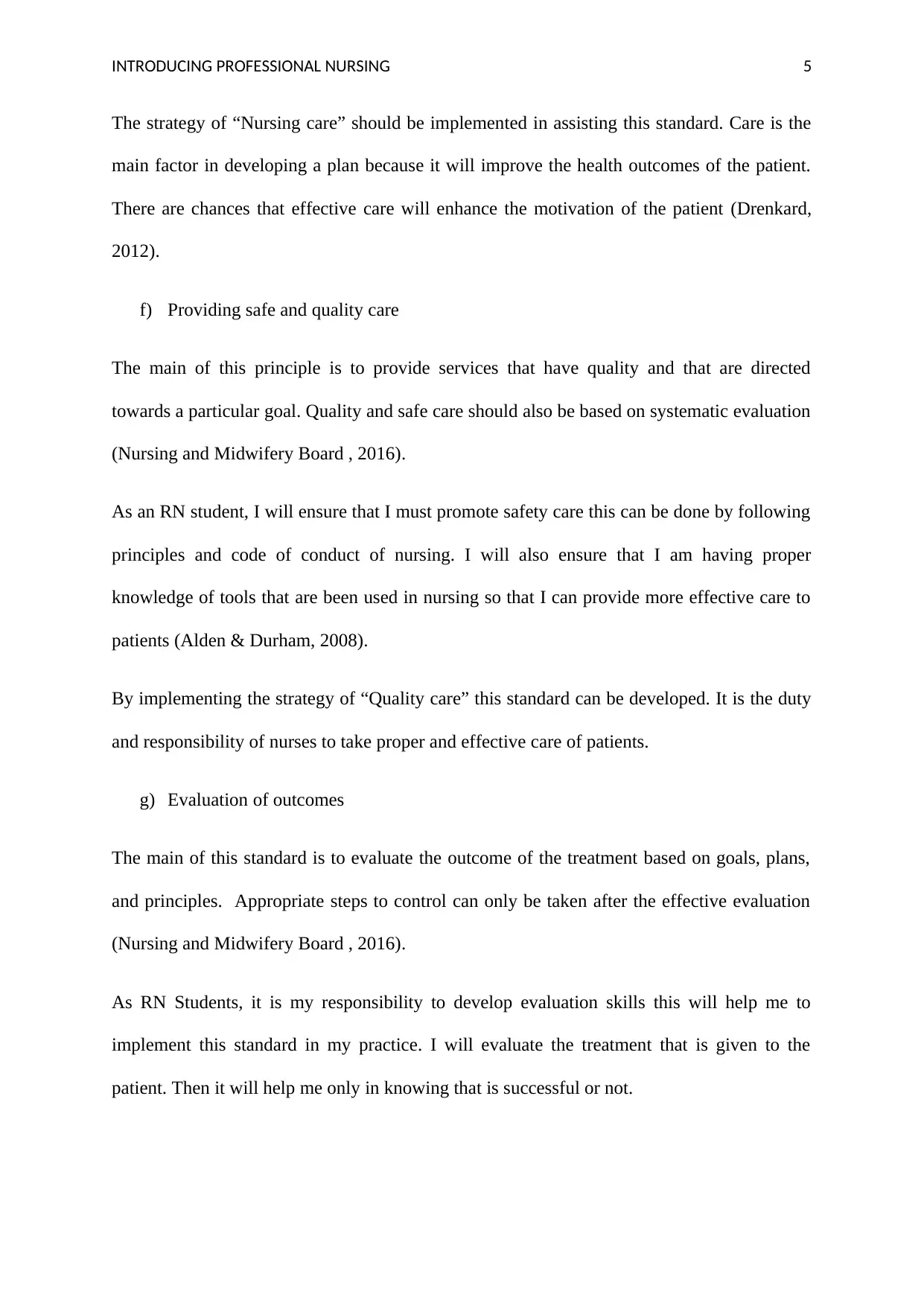
INTRODUCING PROFESSIONAL NURSING 5
The strategy of “Nursing care” should be implemented in assisting this standard. Care is the
main factor in developing a plan because it will improve the health outcomes of the patient.
There are chances that effective care will enhance the motivation of the patient (Drenkard,
2012).
f) Providing safe and quality care
The main of this principle is to provide services that have quality and that are directed
towards a particular goal. Quality and safe care should also be based on systematic evaluation
(Nursing and Midwifery Board , 2016).
As an RN student, I will ensure that I must promote safety care this can be done by following
principles and code of conduct of nursing. I will also ensure that I am having proper
knowledge of tools that are been used in nursing so that I can provide more effective care to
patients (Alden & Durham, 2008).
By implementing the strategy of “Quality care” this standard can be developed. It is the duty
and responsibility of nurses to take proper and effective care of patients.
g) Evaluation of outcomes
The main of this standard is to evaluate the outcome of the treatment based on goals, plans,
and principles. Appropriate steps to control can only be taken after the effective evaluation
(Nursing and Midwifery Board , 2016).
As RN Students, it is my responsibility to develop evaluation skills this will help me to
implement this standard in my practice. I will evaluate the treatment that is given to the
patient. Then it will help me only in knowing that is successful or not.
The strategy of “Nursing care” should be implemented in assisting this standard. Care is the
main factor in developing a plan because it will improve the health outcomes of the patient.
There are chances that effective care will enhance the motivation of the patient (Drenkard,
2012).
f) Providing safe and quality care
The main of this principle is to provide services that have quality and that are directed
towards a particular goal. Quality and safe care should also be based on systematic evaluation
(Nursing and Midwifery Board , 2016).
As an RN student, I will ensure that I must promote safety care this can be done by following
principles and code of conduct of nursing. I will also ensure that I am having proper
knowledge of tools that are been used in nursing so that I can provide more effective care to
patients (Alden & Durham, 2008).
By implementing the strategy of “Quality care” this standard can be developed. It is the duty
and responsibility of nurses to take proper and effective care of patients.
g) Evaluation of outcomes
The main of this standard is to evaluate the outcome of the treatment based on goals, plans,
and principles. Appropriate steps to control can only be taken after the effective evaluation
(Nursing and Midwifery Board , 2016).
As RN Students, it is my responsibility to develop evaluation skills this will help me to
implement this standard in my practice. I will evaluate the treatment that is given to the
patient. Then it will help me only in knowing that is successful or not.
⊘ This is a preview!⊘
Do you want full access?
Subscribe today to unlock all pages.

Trusted by 1+ million students worldwide
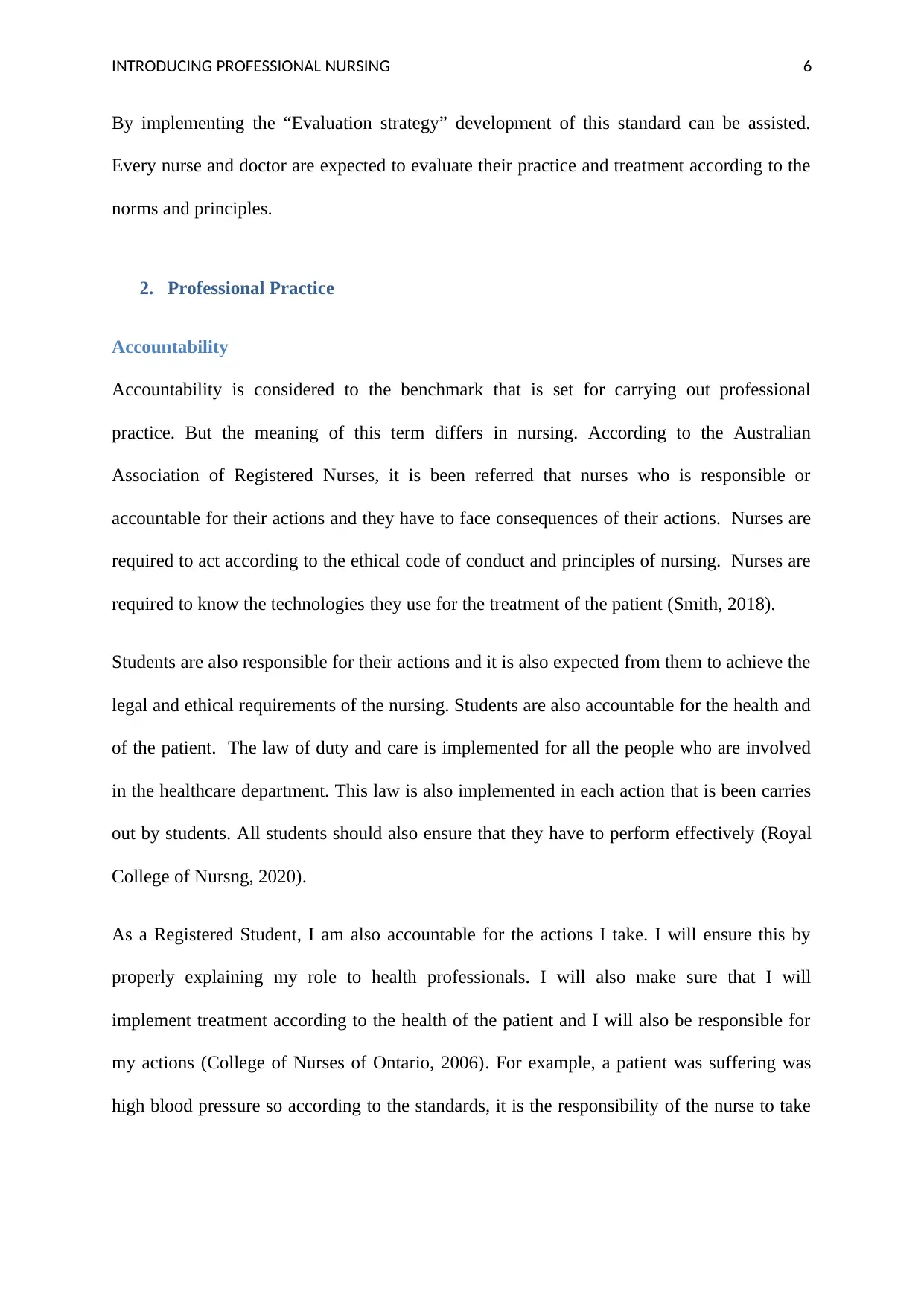
INTRODUCING PROFESSIONAL NURSING 6
By implementing the “Evaluation strategy” development of this standard can be assisted.
Every nurse and doctor are expected to evaluate their practice and treatment according to the
norms and principles.
2. Professional Practice
Accountability
Accountability is considered to the benchmark that is set for carrying out professional
practice. But the meaning of this term differs in nursing. According to the Australian
Association of Registered Nurses, it is been referred that nurses who is responsible or
accountable for their actions and they have to face consequences of their actions. Nurses are
required to act according to the ethical code of conduct and principles of nursing. Nurses are
required to know the technologies they use for the treatment of the patient (Smith, 2018).
Students are also responsible for their actions and it is also expected from them to achieve the
legal and ethical requirements of the nursing. Students are also accountable for the health and
of the patient. The law of duty and care is implemented for all the people who are involved
in the healthcare department. This law is also implemented in each action that is been carries
out by students. All students should also ensure that they have to perform effectively (Royal
College of Nursng, 2020).
As a Registered Student, I am also accountable for the actions I take. I will ensure this by
properly explaining my role to health professionals. I will also make sure that I will
implement treatment according to the health of the patient and I will also be responsible for
my actions (College of Nurses of Ontario, 2006). For example, a patient was suffering was
high blood pressure so according to the standards, it is the responsibility of the nurse to take
By implementing the “Evaluation strategy” development of this standard can be assisted.
Every nurse and doctor are expected to evaluate their practice and treatment according to the
norms and principles.
2. Professional Practice
Accountability
Accountability is considered to the benchmark that is set for carrying out professional
practice. But the meaning of this term differs in nursing. According to the Australian
Association of Registered Nurses, it is been referred that nurses who is responsible or
accountable for their actions and they have to face consequences of their actions. Nurses are
required to act according to the ethical code of conduct and principles of nursing. Nurses are
required to know the technologies they use for the treatment of the patient (Smith, 2018).
Students are also responsible for their actions and it is also expected from them to achieve the
legal and ethical requirements of the nursing. Students are also accountable for the health and
of the patient. The law of duty and care is implemented for all the people who are involved
in the healthcare department. This law is also implemented in each action that is been carries
out by students. All students should also ensure that they have to perform effectively (Royal
College of Nursng, 2020).
As a Registered Student, I am also accountable for the actions I take. I will ensure this by
properly explaining my role to health professionals. I will also make sure that I will
implement treatment according to the health of the patient and I will also be responsible for
my actions (College of Nurses of Ontario, 2006). For example, a patient was suffering was
high blood pressure so according to the standards, it is the responsibility of the nurse to take
Paraphrase This Document
Need a fresh take? Get an instant paraphrase of this document with our AI Paraphraser
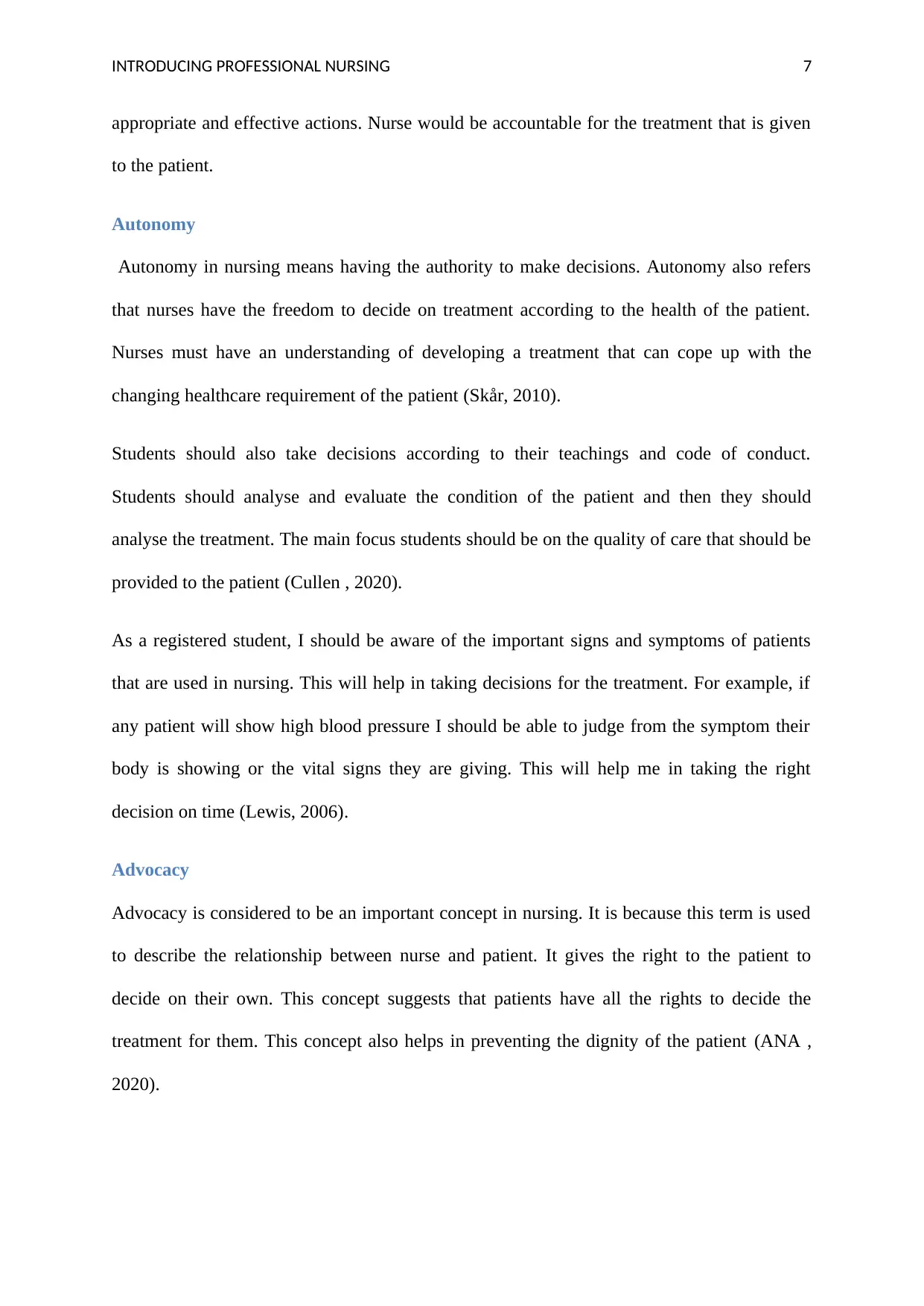
INTRODUCING PROFESSIONAL NURSING 7
appropriate and effective actions. Nurse would be accountable for the treatment that is given
to the patient.
Autonomy
Autonomy in nursing means having the authority to make decisions. Autonomy also refers
that nurses have the freedom to decide on treatment according to the health of the patient.
Nurses must have an understanding of developing a treatment that can cope up with the
changing healthcare requirement of the patient (Skår, 2010).
Students should also take decisions according to their teachings and code of conduct.
Students should analyse and evaluate the condition of the patient and then they should
analyse the treatment. The main focus students should be on the quality of care that should be
provided to the patient (Cullen , 2020).
As a registered student, I should be aware of the important signs and symptoms of patients
that are used in nursing. This will help in taking decisions for the treatment. For example, if
any patient will show high blood pressure I should be able to judge from the symptom their
body is showing or the vital signs they are giving. This will help me in taking the right
decision on time (Lewis, 2006).
Advocacy
Advocacy is considered to be an important concept in nursing. It is because this term is used
to describe the relationship between nurse and patient. It gives the right to the patient to
decide on their own. This concept suggests that patients have all the rights to decide the
treatment for them. This concept also helps in preventing the dignity of the patient (ANA ,
2020).
appropriate and effective actions. Nurse would be accountable for the treatment that is given
to the patient.
Autonomy
Autonomy in nursing means having the authority to make decisions. Autonomy also refers
that nurses have the freedom to decide on treatment according to the health of the patient.
Nurses must have an understanding of developing a treatment that can cope up with the
changing healthcare requirement of the patient (Skår, 2010).
Students should also take decisions according to their teachings and code of conduct.
Students should analyse and evaluate the condition of the patient and then they should
analyse the treatment. The main focus students should be on the quality of care that should be
provided to the patient (Cullen , 2020).
As a registered student, I should be aware of the important signs and symptoms of patients
that are used in nursing. This will help in taking decisions for the treatment. For example, if
any patient will show high blood pressure I should be able to judge from the symptom their
body is showing or the vital signs they are giving. This will help me in taking the right
decision on time (Lewis, 2006).
Advocacy
Advocacy is considered to be an important concept in nursing. It is because this term is used
to describe the relationship between nurse and patient. It gives the right to the patient to
decide on their own. This concept suggests that patients have all the rights to decide the
treatment for them. This concept also helps in preventing the dignity of the patient (ANA ,
2020).
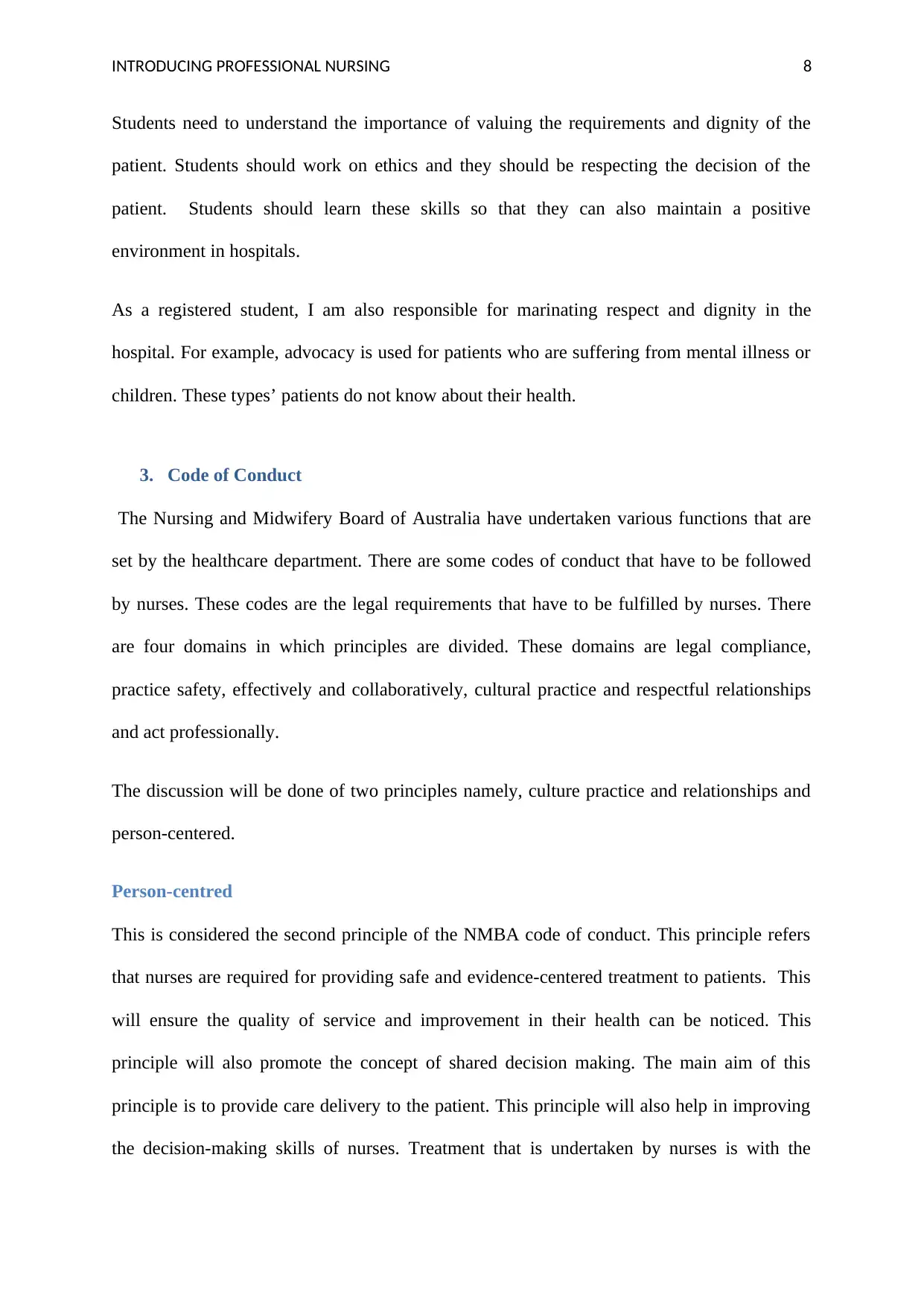
INTRODUCING PROFESSIONAL NURSING 8
Students need to understand the importance of valuing the requirements and dignity of the
patient. Students should work on ethics and they should be respecting the decision of the
patient. Students should learn these skills so that they can also maintain a positive
environment in hospitals.
As a registered student, I am also responsible for marinating respect and dignity in the
hospital. For example, advocacy is used for patients who are suffering from mental illness or
children. These types’ patients do not know about their health.
3. Code of Conduct
The Nursing and Midwifery Board of Australia have undertaken various functions that are
set by the healthcare department. There are some codes of conduct that have to be followed
by nurses. These codes are the legal requirements that have to be fulfilled by nurses. There
are four domains in which principles are divided. These domains are legal compliance,
practice safety, effectively and collaboratively, cultural practice and respectful relationships
and act professionally.
The discussion will be done of two principles namely, culture practice and relationships and
person-centered.
Person-centred
This is considered the second principle of the NMBA code of conduct. This principle refers
that nurses are required for providing safe and evidence-centered treatment to patients. This
will ensure the quality of service and improvement in their health can be noticed. This
principle will also promote the concept of shared decision making. The main aim of this
principle is to provide care delivery to the patient. This principle will also help in improving
the decision-making skills of nurses. Treatment that is undertaken by nurses is with the
Students need to understand the importance of valuing the requirements and dignity of the
patient. Students should work on ethics and they should be respecting the decision of the
patient. Students should learn these skills so that they can also maintain a positive
environment in hospitals.
As a registered student, I am also responsible for marinating respect and dignity in the
hospital. For example, advocacy is used for patients who are suffering from mental illness or
children. These types’ patients do not know about their health.
3. Code of Conduct
The Nursing and Midwifery Board of Australia have undertaken various functions that are
set by the healthcare department. There are some codes of conduct that have to be followed
by nurses. These codes are the legal requirements that have to be fulfilled by nurses. There
are four domains in which principles are divided. These domains are legal compliance,
practice safety, effectively and collaboratively, cultural practice and respectful relationships
and act professionally.
The discussion will be done of two principles namely, culture practice and relationships and
person-centered.
Person-centred
This is considered the second principle of the NMBA code of conduct. This principle refers
that nurses are required for providing safe and evidence-centered treatment to patients. This
will ensure the quality of service and improvement in their health can be noticed. This
principle will also promote the concept of shared decision making. The main aim of this
principle is to provide care delivery to the patient. This principle will also help in improving
the decision-making skills of nurses. Treatment that is undertaken by nurses is with the
⊘ This is a preview!⊘
Do you want full access?
Subscribe today to unlock all pages.

Trusted by 1+ million students worldwide
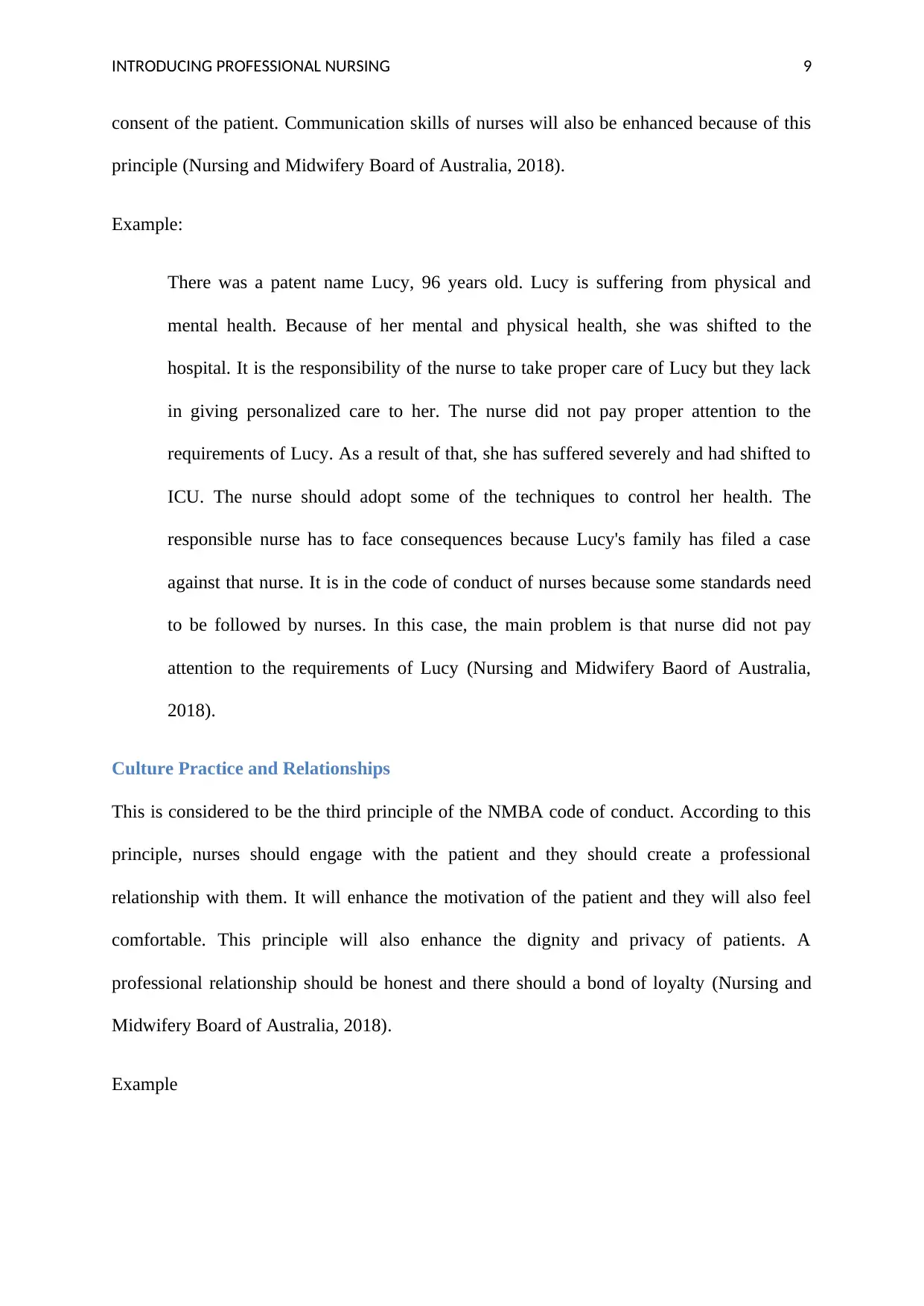
INTRODUCING PROFESSIONAL NURSING 9
consent of the patient. Communication skills of nurses will also be enhanced because of this
principle (Nursing and Midwifery Board of Australia, 2018).
Example:
There was a patent name Lucy, 96 years old. Lucy is suffering from physical and
mental health. Because of her mental and physical health, she was shifted to the
hospital. It is the responsibility of the nurse to take proper care of Lucy but they lack
in giving personalized care to her. The nurse did not pay proper attention to the
requirements of Lucy. As a result of that, she has suffered severely and had shifted to
ICU. The nurse should adopt some of the techniques to control her health. The
responsible nurse has to face consequences because Lucy's family has filed a case
against that nurse. It is in the code of conduct of nurses because some standards need
to be followed by nurses. In this case, the main problem is that nurse did not pay
attention to the requirements of Lucy (Nursing and Midwifery Baord of Australia,
2018).
Culture Practice and Relationships
This is considered to be the third principle of the NMBA code of conduct. According to this
principle, nurses should engage with the patient and they should create a professional
relationship with them. It will enhance the motivation of the patient and they will also feel
comfortable. This principle will also enhance the dignity and privacy of patients. A
professional relationship should be honest and there should a bond of loyalty (Nursing and
Midwifery Board of Australia, 2018).
Example
consent of the patient. Communication skills of nurses will also be enhanced because of this
principle (Nursing and Midwifery Board of Australia, 2018).
Example:
There was a patent name Lucy, 96 years old. Lucy is suffering from physical and
mental health. Because of her mental and physical health, she was shifted to the
hospital. It is the responsibility of the nurse to take proper care of Lucy but they lack
in giving personalized care to her. The nurse did not pay proper attention to the
requirements of Lucy. As a result of that, she has suffered severely and had shifted to
ICU. The nurse should adopt some of the techniques to control her health. The
responsible nurse has to face consequences because Lucy's family has filed a case
against that nurse. It is in the code of conduct of nurses because some standards need
to be followed by nurses. In this case, the main problem is that nurse did not pay
attention to the requirements of Lucy (Nursing and Midwifery Baord of Australia,
2018).
Culture Practice and Relationships
This is considered to be the third principle of the NMBA code of conduct. According to this
principle, nurses should engage with the patient and they should create a professional
relationship with them. It will enhance the motivation of the patient and they will also feel
comfortable. This principle will also enhance the dignity and privacy of patients. A
professional relationship should be honest and there should a bond of loyalty (Nursing and
Midwifery Board of Australia, 2018).
Example
Paraphrase This Document
Need a fresh take? Get an instant paraphrase of this document with our AI Paraphraser
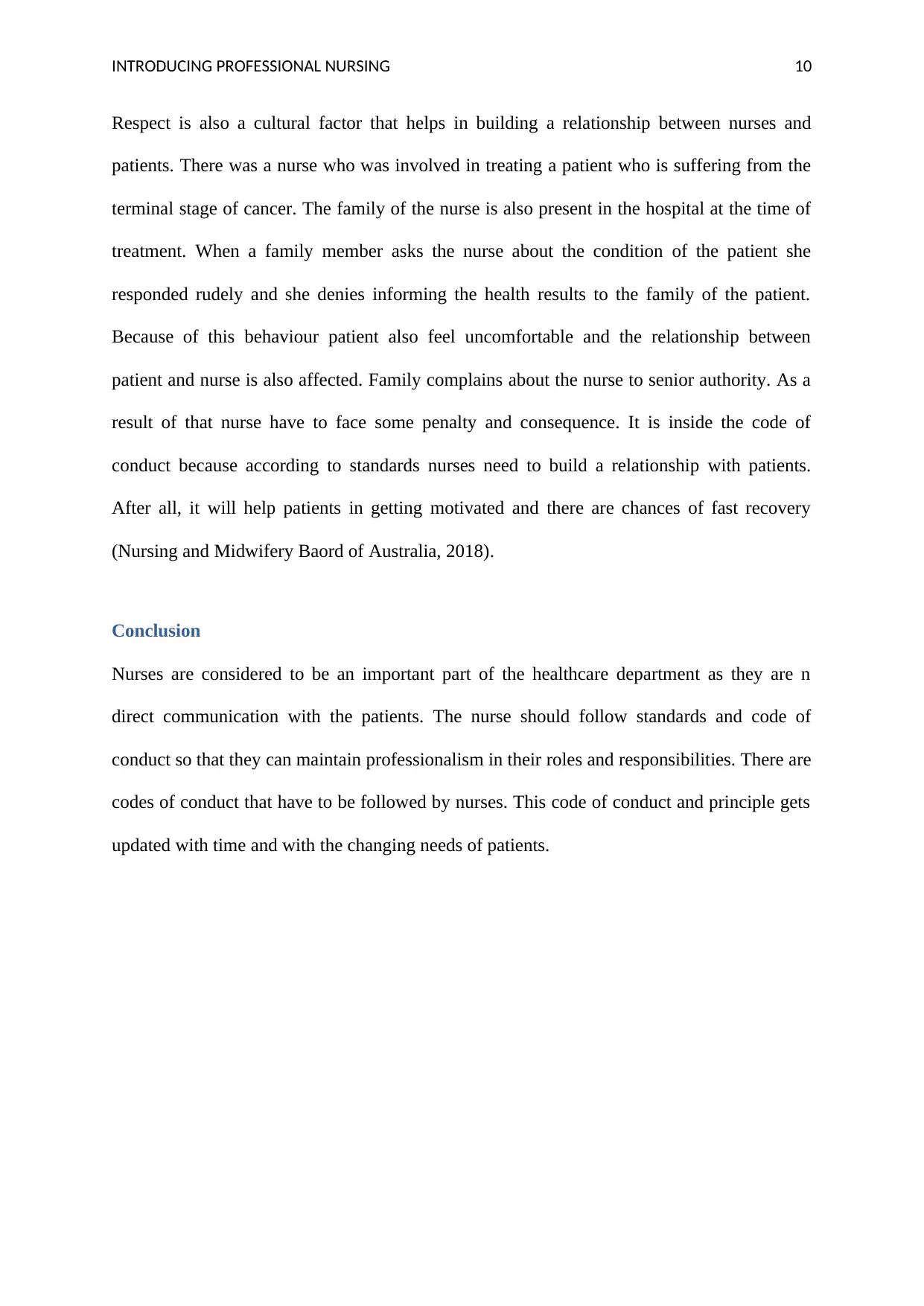
INTRODUCING PROFESSIONAL NURSING 10
Respect is also a cultural factor that helps in building a relationship between nurses and
patients. There was a nurse who was involved in treating a patient who is suffering from the
terminal stage of cancer. The family of the nurse is also present in the hospital at the time of
treatment. When a family member asks the nurse about the condition of the patient she
responded rudely and she denies informing the health results to the family of the patient.
Because of this behaviour patient also feel uncomfortable and the relationship between
patient and nurse is also affected. Family complains about the nurse to senior authority. As a
result of that nurse have to face some penalty and consequence. It is inside the code of
conduct because according to standards nurses need to build a relationship with patients.
After all, it will help patients in getting motivated and there are chances of fast recovery
(Nursing and Midwifery Baord of Australia, 2018).
Conclusion
Nurses are considered to be an important part of the healthcare department as they are n
direct communication with the patients. The nurse should follow standards and code of
conduct so that they can maintain professionalism in their roles and responsibilities. There are
codes of conduct that have to be followed by nurses. This code of conduct and principle gets
updated with time and with the changing needs of patients.
Respect is also a cultural factor that helps in building a relationship between nurses and
patients. There was a nurse who was involved in treating a patient who is suffering from the
terminal stage of cancer. The family of the nurse is also present in the hospital at the time of
treatment. When a family member asks the nurse about the condition of the patient she
responded rudely and she denies informing the health results to the family of the patient.
Because of this behaviour patient also feel uncomfortable and the relationship between
patient and nurse is also affected. Family complains about the nurse to senior authority. As a
result of that nurse have to face some penalty and consequence. It is inside the code of
conduct because according to standards nurses need to build a relationship with patients.
After all, it will help patients in getting motivated and there are chances of fast recovery
(Nursing and Midwifery Baord of Australia, 2018).
Conclusion
Nurses are considered to be an important part of the healthcare department as they are n
direct communication with the patients. The nurse should follow standards and code of
conduct so that they can maintain professionalism in their roles and responsibilities. There are
codes of conduct that have to be followed by nurses. This code of conduct and principle gets
updated with time and with the changing needs of patients.
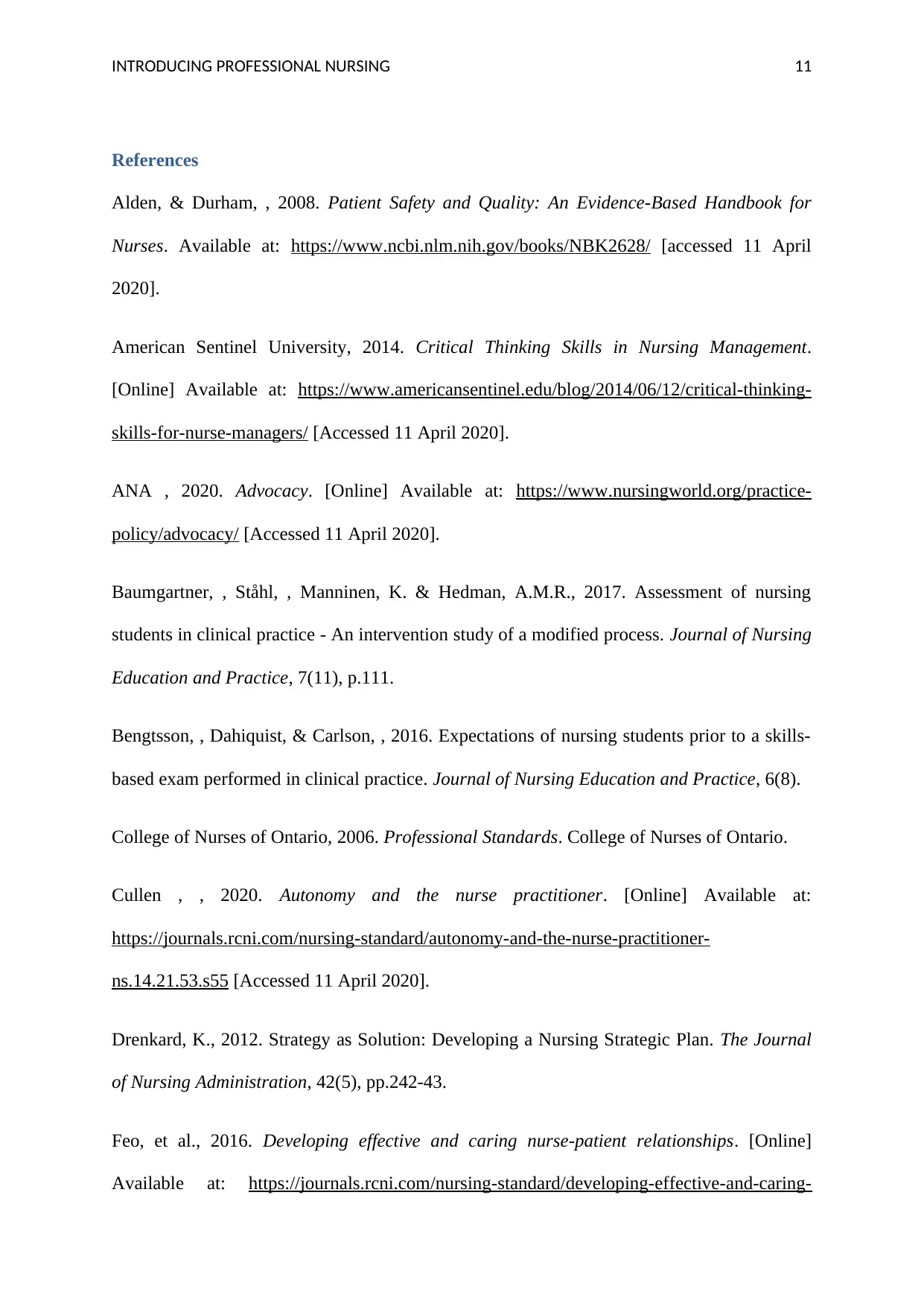
INTRODUCING PROFESSIONAL NURSING 11
References
Alden, & Durham, , 2008. Patient Safety and Quality: An Evidence-Based Handbook for
Nurses. Available at: https://www.ncbi.nlm.nih.gov/books/NBK2628/ [accessed 11 April
2020].
American Sentinel University, 2014. Critical Thinking Skills in Nursing Management.
[Online] Available at: https://www.americansentinel.edu/blog/2014/06/12/critical-thinking-
skills-for-nurse-managers/ [Accessed 11 April 2020].
ANA , 2020. Advocacy. [Online] Available at: https://www.nursingworld.org/practice-
policy/advocacy/ [Accessed 11 April 2020].
Baumgartner, , Ståhl, , Manninen, K. & Hedman, A.M.R., 2017. Assessment of nursing
students in clinical practice - An intervention study of a modified process. Journal of Nursing
Education and Practice, 7(11), p.111.
Bengtsson, , Dahiquist, & Carlson, , 2016. Expectations of nursing students prior to a skills-
based exam performed in clinical practice. Journal of Nursing Education and Practice, 6(8).
College of Nurses of Ontario, 2006. Professional Standards. College of Nurses of Ontario.
Cullen , , 2020. Autonomy and the nurse practitioner. [Online] Available at:
https://journals.rcni.com/nursing-standard/autonomy-and-the-nurse-practitioner-
ns.14.21.53.s55 [Accessed 11 April 2020].
Drenkard, K., 2012. Strategy as Solution: Developing a Nursing Strategic Plan. The Journal
of Nursing Administration, 42(5), pp.242-43.
Feo, et al., 2016. Developing effective and caring nurse-patient relationships. [Online]
Available at: https://journals.rcni.com/nursing-standard/developing-effective-and-caring-
References
Alden, & Durham, , 2008. Patient Safety and Quality: An Evidence-Based Handbook for
Nurses. Available at: https://www.ncbi.nlm.nih.gov/books/NBK2628/ [accessed 11 April
2020].
American Sentinel University, 2014. Critical Thinking Skills in Nursing Management.
[Online] Available at: https://www.americansentinel.edu/blog/2014/06/12/critical-thinking-
skills-for-nurse-managers/ [Accessed 11 April 2020].
ANA , 2020. Advocacy. [Online] Available at: https://www.nursingworld.org/practice-
policy/advocacy/ [Accessed 11 April 2020].
Baumgartner, , Ståhl, , Manninen, K. & Hedman, A.M.R., 2017. Assessment of nursing
students in clinical practice - An intervention study of a modified process. Journal of Nursing
Education and Practice, 7(11), p.111.
Bengtsson, , Dahiquist, & Carlson, , 2016. Expectations of nursing students prior to a skills-
based exam performed in clinical practice. Journal of Nursing Education and Practice, 6(8).
College of Nurses of Ontario, 2006. Professional Standards. College of Nurses of Ontario.
Cullen , , 2020. Autonomy and the nurse practitioner. [Online] Available at:
https://journals.rcni.com/nursing-standard/autonomy-and-the-nurse-practitioner-
ns.14.21.53.s55 [Accessed 11 April 2020].
Drenkard, K., 2012. Strategy as Solution: Developing a Nursing Strategic Plan. The Journal
of Nursing Administration, 42(5), pp.242-43.
Feo, et al., 2016. Developing effective and caring nurse-patient relationships. [Online]
Available at: https://journals.rcni.com/nursing-standard/developing-effective-and-caring-
⊘ This is a preview!⊘
Do you want full access?
Subscribe today to unlock all pages.

Trusted by 1+ million students worldwide
1 out of 14
Related Documents
Your All-in-One AI-Powered Toolkit for Academic Success.
+13062052269
info@desklib.com
Available 24*7 on WhatsApp / Email
![[object Object]](/_next/static/media/star-bottom.7253800d.svg)
Unlock your academic potential
Copyright © 2020–2025 A2Z Services. All Rights Reserved. Developed and managed by ZUCOL.





